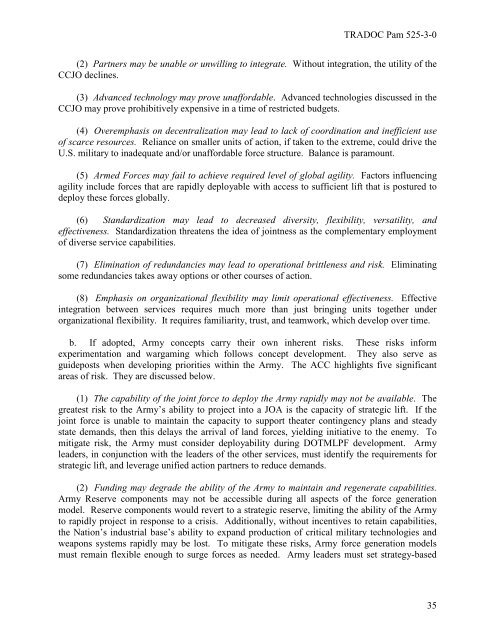U.S. Army Capstone Concept (PDF) - Defense Innovation Marketplace
U.S. Army Capstone Concept (PDF) - Defense Innovation Marketplace
U.S. Army Capstone Concept (PDF) - Defense Innovation Marketplace
Create successful ePaper yourself
Turn your PDF publications into a flip-book with our unique Google optimized e-Paper software.
TRADOC Pam 525-3-0(2) Partners may be unable or unwilling to integrate. Without integration, the utility of theCCJO declines.(3) Advanced technology may prove unaffordable. Advanced technologies discussed in theCCJO may prove prohibitively expensive in a time of restricted budgets.(4) Overemphasis on decentralization may lead to lack of coordination and inefficient useof scarce resources. Reliance on smaller units of action, if taken to the extreme, could drive theU.S. military to inadequate and/or unaffordable force structure. Balance is paramount.(5) Armed Forces may fail to achieve required level of global agility. Factors influencingagility include forces that are rapidly deployable with access to sufficient lift that is postured todeploy these forces globally.(6) Standardization may lead to decreased diversity, flexibility, versatility, andeffectiveness. Standardization threatens the idea of jointness as the complementary employmentof diverse service capabilities.(7) Elimination of redundancies may lead to operational brittleness and risk. Eliminatingsome redundancies takes away options or other courses of action.(8) Emphasis on organizational flexibility may limit operational effectiveness. Effectiveintegration between services requires much more than just bringing units together underorganizational flexibility. It requires familiarity, trust, and teamwork, which develop over time.b. If adopted, <strong>Army</strong> concepts carry their own inherent risks. These risks informexperimentation and wargaming which follows concept development. They also serve asguideposts when developing priorities within the <strong>Army</strong>. The ACC highlights five significantareas of risk. They are discussed below.(1) The capability of the joint force to deploy the <strong>Army</strong> rapidly may not be available. Thegreatest risk to the <strong>Army</strong>’s ability to project into a JOA is the capacity of strategic lift. If thejoint force is unable to maintain the capacity to support theater contingency plans and steadystate demands, then this delays the arrival of land forces, yielding initiative to the enemy. Tomitigate risk, the <strong>Army</strong> must consider deployability during DOTMLPF development. <strong>Army</strong>leaders, in conjunction with the leaders of the other services, must identify the requirements forstrategic lift, and leverage unified action partners to reduce demands.(2) Funding may degrade the ability of the <strong>Army</strong> to maintain and regenerate capabilities.<strong>Army</strong> Reserve components may not be accessible during all aspects of the force generationmodel. Reserve components would revert to a strategic reserve, limiting the ability of the <strong>Army</strong>to rapidly project in response to a crisis. Additionally, without incentives to retain capabilities,the Nation’s industrial base’s ability to expand production of critical military technologies andweapons systems rapidly may be lost. To mitigate these risks, <strong>Army</strong> force generation modelsmust remain flexible enough to surge forces as needed. <strong>Army</strong> leaders must set strategy-based35

















